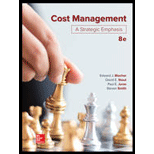
1.
Calculate the actual operating income for the period.
1.
Explanation of Solution
Calculate the actual operating income for the period.
2.
Calculate the company’s master (static) budget operating income for the period.
2.
Explanation of Solution
Calculate the company’s master (static) budget operating income for the period.
3 (a) & 3 (b)
Calculate the total master (static)
3 (a) & 3 (b)
Explanation of Solution
Calculate the company’s master (static) budget operating income for the period:
Thus, the variance is unfavorable.
4 (a) and 4 (b).
Calculate the total flexible budget variance for the period and identify whether the variance is favorable or unfavorable.
4 (a) and 4 (b).
Explanation of Solution
The first-level decomposition of the total master (static) budget variance in operating income is attained through the implementation of a flexible-budget (depending on actual sales volume for the period). In this situation, the flexible-budget operating income
Calculate total flexible budget variance:
Note 1:
Note 2:
4 (c) and 4 (d).
Calculate the sales volume variance and identify whether the variance is favorable or unfavorable.
4 (c) and 4 (d).
Explanation of Solution
Calculate the sales volume variance and identify whether the variance is favorable or unfavorable.
Conclusion:
| Actual Results | Flexible Budget | ||
| Unit sales | 40,000 | 40,000 | 45,000 |
| Sales | $380,000 | $400,000 | $450,000 |
| Total variable expenses | 210,000 | 240,000 | 270,000 |
| Contribution margin | $170,000 | $160,000 | $180,000 |
| Fixed expenses | 145,000 | 135,000 | 135,000 |
| Operating income | $25,000 | $25,000 | $45,000 |
Table (1)
Calculate total master (static) budget variance:
Calculate flexible-budget variance:
Calculate sales volume variance:
5.
5.
Explanation of Solution
- The sales volume variance indicates the effect on operating profit of selling a different volume of sales associated to the budgeted volume reflected in the master budget. Likewise, the computation of the variance holds three other elements constant: “selling price per unit, variable cost per unit, and total fixed costs”.
- It is to be noted that this variance could be explained with respect to contribution margin, in this context, the computation looks at the effect on contribution margin of selling an amount different from the sales volume shown in the master budget for the period.
- The total flexible-budget variance indicates the composite impact on operating income of changes in three components: “selling price per unit, variable cost per unit, and total fixed costs:
- Therefore, in computing the flexible-budget variance we “hold constant” sales volume. There is a zero flexible-budget variance, in this context.
- Conversely, this does not indicate that there is “no variable cost flexible budget variance, no selling price variance or no fixed cost spending variance”. It just means that these three variances net to zero.
Want to see more full solutions like this?
Chapter 14 Solutions
Cost Management
- Given solution for General accounting question not use aiarrow_forwardKindly help me with this General accounting questions not use chart gpt please fast given solutionarrow_forwardI am trying to find the accurate solution to this financial accounting problem with appropriate explanations.arrow_forward
- Please given correct answer for General accounting question I need step by step explanationarrow_forwardPlease provide the answer to this financial accounting question using the right approach.arrow_forwardI want to this question answer for General accounting question not need ai solutionarrow_forward
- Can you solve this financial accounting problem using accurate calculation methods?arrow_forwardCan you explain the process for solving this financial accounting question accurately?arrow_forwardHello tutor please given General accounting question answer do fast and properly explain all answerarrow_forward

 AccountingAccountingISBN:9781337272094Author:WARREN, Carl S., Reeve, James M., Duchac, Jonathan E.Publisher:Cengage Learning,
AccountingAccountingISBN:9781337272094Author:WARREN, Carl S., Reeve, James M., Duchac, Jonathan E.Publisher:Cengage Learning, Accounting Information SystemsAccountingISBN:9781337619202Author:Hall, James A.Publisher:Cengage Learning,
Accounting Information SystemsAccountingISBN:9781337619202Author:Hall, James A.Publisher:Cengage Learning, Horngren's Cost Accounting: A Managerial Emphasis...AccountingISBN:9780134475585Author:Srikant M. Datar, Madhav V. RajanPublisher:PEARSON
Horngren's Cost Accounting: A Managerial Emphasis...AccountingISBN:9780134475585Author:Srikant M. Datar, Madhav V. RajanPublisher:PEARSON Intermediate AccountingAccountingISBN:9781259722660Author:J. David Spiceland, Mark W. Nelson, Wayne M ThomasPublisher:McGraw-Hill Education
Intermediate AccountingAccountingISBN:9781259722660Author:J. David Spiceland, Mark W. Nelson, Wayne M ThomasPublisher:McGraw-Hill Education Financial and Managerial AccountingAccountingISBN:9781259726705Author:John J Wild, Ken W. Shaw, Barbara Chiappetta Fundamental Accounting PrinciplesPublisher:McGraw-Hill Education
Financial and Managerial AccountingAccountingISBN:9781259726705Author:John J Wild, Ken W. Shaw, Barbara Chiappetta Fundamental Accounting PrinciplesPublisher:McGraw-Hill Education





